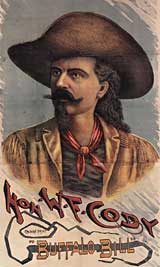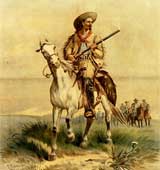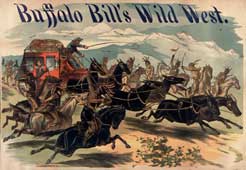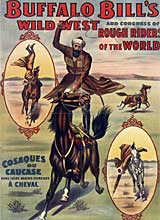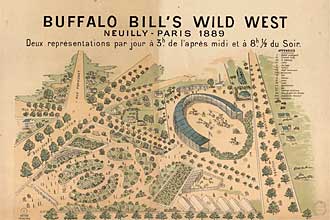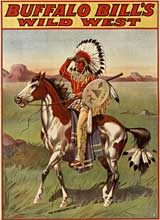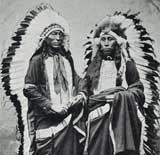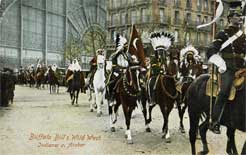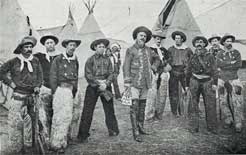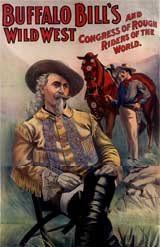by Jeanne-Yvonne and Gérard Borg
William Frederick Cody, born in 1846 in an Iowa cabin, earned his pseudonym as "Buffalo Bill" by killing a dozen buffalo every day to feed the workers of the Kansas Pacific Railroad on the Western Plains. He hunted more than 3,000 buffalo in 8 months. He then spent 12 years as an assigned scout for General Sheridan in the 5th Cavalry Regiment, transporting urgent dispatches to hostile areas, riding 464 kilometres in less than sixty hours.
His legend was born under the pen of Ned Buntline, who staged a play in New York in 1872 under the title Buffalo Bill, The King of the Border Men. The author persuaded him to leave the army for a theatrical career that began in Chicago in June 1873 with The Scouts of the Prairie. Buffalo Bill became aware of the public's attraction to the Wild West and brought together a group of Indians and cowboys: The Buffalo Bill Combination company performed on stage in the winter, while Cody continued his scouting or hunting guiding parties activities during the summer months. The western genre was born.
While P. T. Barnum had created shows featuring Indian life, Cody organised a Fourth of July observance in 1882 in North Plate with a gathering of 1,000 cowboys and envisioned a Wild West Show. The premiere took place on May 17, 1883 in front of 8,000 spectators applauding processions, parades, Deadwood's stagecoach attack and shooting and rodeo exercises. Nate Salsbury, a new partner and financier, and John Burke, a brilliant press officer, organised their first summer tour, starting in Chicago in 1884, at a cost of $100,000. Cody produces this Wild west show in 40 cities across the United States and Canada. He was assisted by Indian Chief Sitting Bull for a few months and sniper Annie Oakley for several years. The show is at its peak.
Invited to Queen Victoria's Golden Jubilee, Cody and the Wild West embarked for London on the "State of Nebraska" in March 1887. The enormous success before the European crowned heads gave him an international dimension as an ambassador for the New World. In New York, Nate Salsbury offered Cody a trip to Paris for the Exposition Universelle of 1889, which was planned to celebrate the centenary of the Revolution, an event enhanced by the inauguration of the Eiffel Tower. In January 1889, Nate headed ahead to Paris with two wagon loads of huge posters that would cover the walls. Cody is portrayed in the centre of a galloping buffalo silhouette, with the striking slogan: "I'm coming".
On the 27th of April 1889 the SS. Persian Monarch leaves New York in the pouring rain. Buffalo and horses are hoisted on board, covered with tarpaulins. Commander Bristow noted the names of the passengers on the logbook: 12 administrators, 6 female artists including Annie Oackley and her rival Lilian Smith, 15 musicians and their musical director William Sweeney, faithful until the farewell tour, Buck Taylor who led the 31 cowboys, Red Shirt and his 103 Indians, 5 squaws and 5 Sioux children but also 3 Canadian trappers, 7 Mexican vaqueros, 29 performers, employees and stagehands. The crossing was marked by a violent storm that frightened the Indians. From the port of Le Havre, the Wild West reaches Paris by special train. There is only one week left to set up in Neuilly on a huge plot of land rented at an exceptional price, the rectangular arena, the stands, the stables, the campsites, the teepees. At each performance, twice a day, 15,000 spectators experience the American West.
In its edition dated 20th of July, La Journée Parisienne describes the show in detail: "Great parade of the troupe and the Red Indians under the direction of Colonel Cody, exploits with Miss Oackley's rifle, the troupe of 200 horses and ponies, the 20 bison, the attack on the Deadwood stagecoach pulled by 6 mules, a battle between Indian tribes, the attack on a Settlers' house". Leading figures in Paris, including Sadi Carnot, Edison, Gauguin, Munch or Rosa Bonheur, visit the cowboys and the Indians. Rosa befriended Cody and created her famous portrait on horseback. The tour continues for more than three years throughout Europe. Cody was invited to the Vatican by Pope Leo XIII. The Indians, dressed in ceremonial dress, wander in gondolas in Venice.
Leaving his troupe for the 1890 wintering season at Benfield near Strasbourg, Cody left for the United States. The scout, who fought the Indians so hard, became their protector. He tried to join Sitting Bull to convince him to lay down his arms against General Miles' armies. But he failed, Sitting Bull was killed, and the rebel Indians exterminated at Wounded Knee on the 29th of December 1890. Cody returned to Europe with a few surviving Indian chiefs and resumed the triumphant tour. With Nate Salsbury the horseman created in 1892 the Congress of Rough Riders of the World by expanding the show with the participation of riders from all over the world: Cossacks, Mexicans, Arabs, Japanese, Prussian Uhlans, British spearmen or Zouaves... Back in the United States, he joined James Bailey who reorganised Wild West logistics along the lines of the Barnum and Bailey Circus. He initiated a real strategy for the American and European tours of the two most formidable shows in the world, where advertising, marked in particular by a huge number of billboards and posters as well as a large-scale production of "derivative products", is taking on an absolutely unprecedented importance.
The European farewell tour began in London in 1902. In 1905, France generated the most fabulous takings, particularly Paris. The camp is located at the Champ de Mars, halfway between the Galerie des Machines and the Eiffel Tower. You can also visit the Side Show, which presents several "phenomena", in the Barnum tradition.
Logistics are impressive and transport from town to town takes place with 4 special trains; the wagons built by James Bailey for the Barnum and Bailey Circus tour in 1902 have been transformed for the Wild West. 800 horses, 10 huge tents and the rectangular arena with a 20,000-spectator capacity, lit by the miracle of the electricity Fairy, the refectories, the kitchen are on board for the ride. The "city for a day" is the rule. 110 cities were visited in 1905. The season ends in Marseille in November for the winter season.
The Wild West Show resumed in March 1906 for a major European tour after Toulon, Draguignan and Nice.
And the show returns to the United States, where James Bailey is dead, and business is down. Several unfortunate associations and the public's lack of interest in an aging model replaced by cinema led to bankruptcy in July 1913. Everything is auctioned off, even Colonel Cody's horse. The great rider performed in a horse-drawn carriage at the Sells-Floto Circus from 1913 to 1915, then with the Miller brothers at 101 Ranch West in 1916. He died of pneumonia in Denver on the 10th of January 1917. The country is in shock and a huge crowd attends the national funeral. The saga of the wild West has died with him. The myth lives on.
Read further on Gallica :![]() Poster, program and postcards of the european tours.
Poster, program and postcards of the european tours.![]() « La Course à la mort » : one out of the first 53 sheets titled Buffalo-Bill, le héros du Far-West (1907-1909).
« La Course à la mort » : one out of the first 53 sheets titled Buffalo-Bill, le héros du Far-West (1907-1909).



